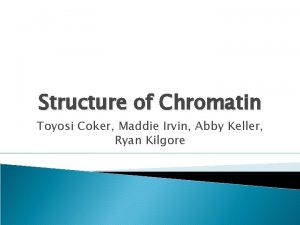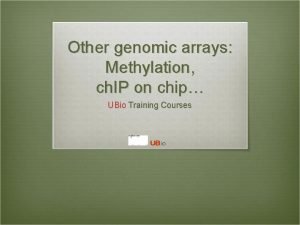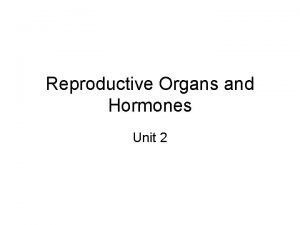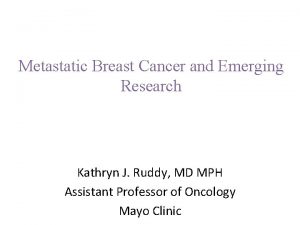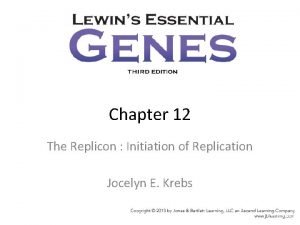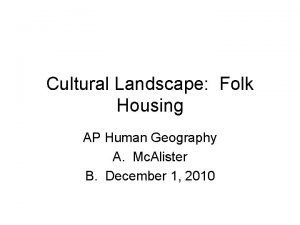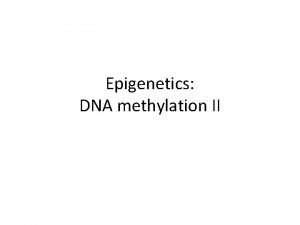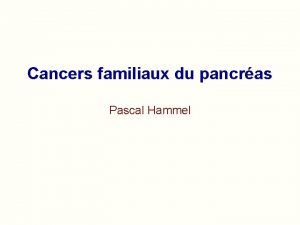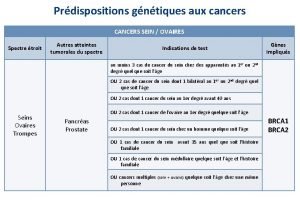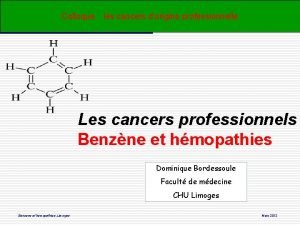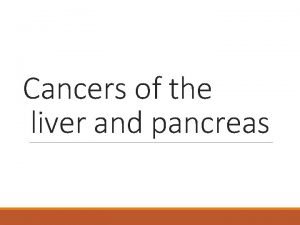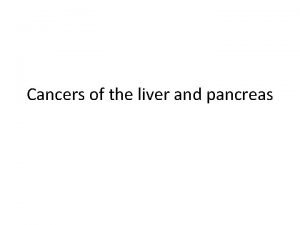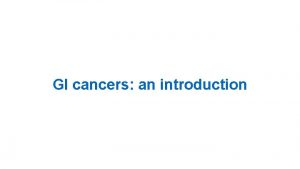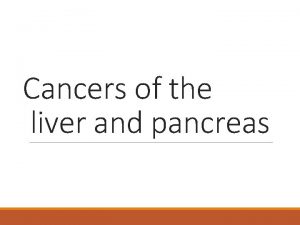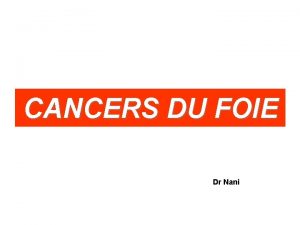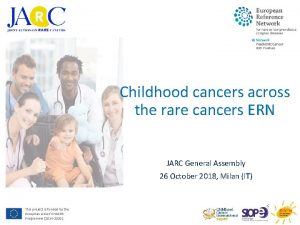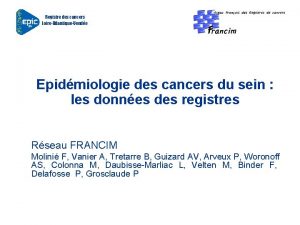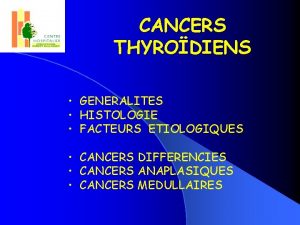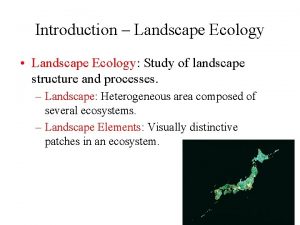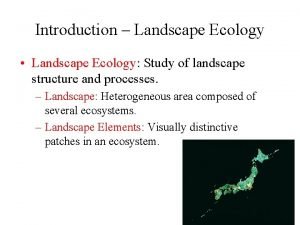The Methylation Landscape of Human Cancers Methylation patterns




































- Slides: 36

The Methylation Landscape of Human Cancers Methylation patterns of cancers using The Cancer Genome Atlas (TCGA) database https: //tcga-data. nci. nih. gov/tcga/ 1

Talk Outline PART #1: DNA Methylation 1. Introduction: a) Biological background: DNA Methylation b) Scientific Questions c) Methodology: TCGA database, Illumina Platform 2. Preliminary data: a) Methylation b) Methylation & expression PART #2: Integrating Mutation & Methylation PART #3: Summary 2

The ‘fifth base’: 5 -methylcytosine Published in February 2001, the rough draft version of the human genome was widely heralded as the “book of life, ” an ∼ 3 -billion-letter code composed of just four letters within which is described our cellular and physiological complexity, and our genetic heritage… Yet the book was missing proper formatting of some of the characters within its pages; omitted from this landmark volume was the elusive and dynamic fifth letter of the code: 5 -methylcytosine… commonly referred to as DNA methylation, is a modified base that imparts an additional layer of heritable information upon the DNA code, which is important for regulating the underlying genetic information. Lister & Ecker, 2009 3

DNA Methylation DNA methylation at Cp. G sites Frequency: 1%– 6% of mammalian & plant genomes (Montero et al. 1992) Roles: heritable information, embryogenesis, development, genomic imprinting, silencing of transposable elements, protection from parasites, regulation of gene expression & splicing Methylated sites ~ Expression • Cp. G methylation in promoter - negatively correlated w/ expression • 70% of human promoters have a high Cp. G content Cp. G Islands • 300 -3000 bp, %GC>50%, OB/EX Cp. G>60% Zaidi S K et al, 2010 4

DNA Methylation in Disease Carcinogenesis: differential methylation – silencing/activating transcription factors, genes, micro. RNAs, pathways Most studies focus on methylation at gene promoters Lahtz C , and Pfeifer G P J Mol Cell Biol 2011; 3: 51 -58

Scientific Questions Methylation 1. Examine methylation patterns across various cancers 2. Clustering cancers using methylation patterns; does methylation pattern identify similar cancers (e. g. of similar embryonic origin)? 3. Identify differentially methylated genes, are they unique to cancer or common to all cancers? Expression ~ Methylation A. Proof of principal: examine correlation between methylation and gene expression (esp. TSS, promoter) B. Use expression to assist with identifying differentially methylated genes C. Selected genes - perform enrichment analysis for implicated pathway 6

Methodology: TCGA database https: //tcga-data. nci. nih. gov/ 7

Methodology: ~7500 Methylation Datasets Abbrev bladder urothelial carcinoma BLCA breast invasive carcinoma BRCA cervical & endocervical cancer CESC colon adenocarcinoma COAD colon & rectum adenocarcinoma COADREAD esophageal carcinoma ESCA glioblastoma multiforme GBM head & neck squamous cell carcinoma HNSC kidney clear cell carcinoma KIRC kidney papillary cell carcinoma KIRP brain lower grade glioma LGG liver hepatocellular carcinoma LIHC lung adenocarcinoma LUAD lung cancer LUNG lung squamous cell carcinoma LUSC pancreatic adenocarcinoma PAAD prostate adenocarcinoma PRAD rectum adenocarcinoma READ sarcoma SARC skin cutaneous melanoma SKCM stomach adenocarcinoma STAD thyroid carcinoma THCA uterine corpus endometrioid carcinoma UCEC Tumor Normal Origin 185 679 163 275 371 63 125 373 299 142 266 125 437 798 361 65 213 96 85 338 261 508 401 20 98 3 38 45 12 1 50 160 45 2 50 32 75 43 9 49 7 4 1 2 56 46 Epithelial Mesenchymal Epithelial Epithelial Neural Epithelial Mesenchymal Epithelial Mesenchymal Neural Epithelial APUD System Epithelial Tumor samples: 6629 Normal Samples: 848 8

Methodology: Uneven genomic distribution of DNA methylation Gene regions Cp. G Islands Island All TSS 1500 TSS 200 5'UTR Exon 1 st Gene. Body 3'UTR 28553 39314 31360 26978 43054 2442 84288 62577 65493 39368 175469 19731 34% 63% 48% 69% 25% 12% Platform: Illumina Infinium Human. Methylation 450 Bead. Chip Coverage: over 450, 000 Cp. G sites, 99% of Ref. Seq genes, 96% of Cp. G Islands 9

Methodology: DNA Methylation Analysis • DNA methylation - measured on a β-distributed absolute scale 0 -1 α offset (by default, α = 100) regularize Beta value when meth. + unmeth. probe intensities are low 1) Calculate mean regional methylation level per gene/Cp. G region for tumor and normal samples 2) Calculate differential methylation (tumor vs. normal) • Tools for DNA methylation analysis using Illumina Methylation 450 Bead. Chip : NIMBL: MATLAB code - Numerical Identification of Methylation Biomarker Lists (Wessely & Emes, 2012) IMA: an R package - Illumina Methylation Analysis (Wang et al. , 2012) 10

Talk Outline PART #1: DNA Methylation 1. Introduction: a) Biological background: DNA Methylation b) Scientific Questions c) Methodology: TCGA database, Illumina Platform 2. Preliminary data: a) Methylation b) Methylation & expression PART #2: Integrating Mutation & Methylation PART #3: Summary 11

Normal & Tumor Methylation: Gene Regions tumor normal 12

Differential Methylation: Gene Regions Next… 1) Differential Methylation of genes comparing beta values β(Normal) –β(Tumor) 2) All genes (no significance filtering) 13

Differential Methylation: Gene Regions TSS 1500 TSS 200 5’UTR All genes (no filtering) 1 st Exon Gene Body 3’UTR 14

Differential Methylation: Gene Regions TSS 1500 1 st Exon Adjusted P< 0. 05 TSS 200 5’UTR Gene Body 3’UTR 15

Differential Methylation: Cp. G Islands & flanking Regions Adjusted P< 0. 05 N Shelf N Shore Cp. G Island S Shore S Shelf 16

Interpretations • Different methylation patterns in different gene regions • Cancers differ in degree of differential methylation which may play more major (or minor) role in specific cancer • Variation in # of hypo/hyper-methylated genes – could indicate differences in enzymatic activity

Next - Proof of principle Integrating expression data with methylation data Goal: recapitulate previous studies showing a negative correlation between promoter methylation and gene expression 18

Correlation between Expression Methylation TSS 1500 r=-0. 17 TSS 200 r=-0. 28 1 st Exon r=-0. 35 Gene body r=-0. 0046 5’UTR r=-0. 28 Example: SKCM Genes were filtered using std>3 on expr. 3’UTR r=0. 17 19

Correlation between Expression Methylation TSS 1500 r=-0. 32 TSS 200 r=-0. 25 1 st Exon r=-0. 28 Gene body r=-0. 035 5’UTR r=-0. 19 Example: KIRP Genes were filtered using std>3 on expr. 3’UTR r=-0. 12 20

Questions for audience • Differential methylation: threshold? P-value? I. e. single cutoff for all cancers or select outlier per cancer • Methylation: loss of data from samples with <5 normal samples • Improve - integration of methylation and expression data to select genes? • Gene methylation across different regions, correlation across different regions

Talk Outline PART #1: DNA Methylation 1. Introduction: a) Biological background: DNA Methylation b) Scientific Questions c) Methodology: TCGA database, Illumina Platform 2. Preliminary data: a) Methylation b) Methylation & expression PART #2: Integrating Mutation & Methylation PART #3: Summary 22

Cancer Mutations Somatic mutation calls Synonymous: Silent mutations Non-Synonymous: Missense, nonsense, frame-shift (indels), splice-site within protein coding region Copy number variation (CNV): e. g. deletions, insertions, duplications, inversions Challenge: identify driver vs. passenger mutations ‘‘driver’’ mutations – confer(ed) fitness advantage to tumor cell ‘‘passenger’’ mutations - never conferred fitness advantage Tools developed in Broad Inst. : Mu. Tect (Cibulskis et al. 2013), Indelocator, Mut. Sig. CV (Lawrence et al. , 2013), Inv. Ex (Hodis et al. , 2012) Driver mutations mainly consider protein coding regions 23

Scientific Questions: Methylation & Mutations 1. Driver mutations Identify mutated Cp. G are drivers, i. e. have functional implications (use conservation? expression? ) 2. Methylation and mutations Are they related? Do they show associations? Do coding and non-coding genes differ? 24

Scientific Questions: Methylation & Mutations 1. Driver mutations Identify mutated Cp. G are drivers, i. e. have functional implications (use conservation? expression? ) 2. Methylation and mutations Are they related? Do they show associations? Do coding and non-coding genes differ? transcription-repair coupling Expression & mutation are related Low expression -> more mutations High expression -> less mutations Lawrence et al. , Nature, 2013 25

Scientific Questions Methylation & Mutations 1. Driver mutations Identify mutated Cp. G are drivers, i. e. have functional implications (use conservation? expression? ) 2. Methylation and mutations Are they related? Do they show associations? Do coding and non-coding genes differ? 3. Effect of cancer mutations on Cp. G landscape Do mutations/CNVs change frequency of Cp. G sites? Effect on methylation? 4. Cancer heterogeneity Tumor clones harbor different lesions, does methylation similarly differ between clones? 26

Talk Outline PART #1: DNA Methylation 1. Introduction: a) Biological background: DNA Methylation b) Scientific Questions c) Methodology: TCGA database, Illumina Platform 2. Preliminary data: a) Methylation b) Methylation & expression PART #2: Integrating Mutation & Methylation PART #3: Summary 27

Summary Methylation 1. Variation in differential methylation patterns across cancers and regions 2. Cancers defer in amount of hypo-/hyper-methylated genes 3. Recapitulated negative correlation between promoter methylation and expression Future Directions 1. Methylation & Expression a. Examine relationship between methylation and expression (per gene region) b. Integrate methylation & expression data to identify diff. methylated genes 2. Methylation & Mutation a. Integrate methylation & mutation data to identify “driver” Cp. G mutations b. examine effect of cancer mutations on Cp. G & methylation 3. Integration Methylation, Mutation & Expression 28

Acknowledgements Dr. Carmit Levy and lab members Prof. Ron Shamir Dvir Netanely Sahar Gelfman Prof. Gil Ast Thank you for listening

Thank you for listening

31

Illumina Platform Infinium Human. Methylation 450 Bead. Chip 32

Illumina Platform Infinium Human. Methylation 450 Bead. Chip 33

Methodology: DNA Methylation Analysis Illumina Methylation Analyzer (IMA) • Calculates Differential methylation for 5’ UTR, first exon, gene body, 3’ UTR, Cp. G island, Cp. G shore, Cp. G shelf • Mean, Median, Tukey’s Biweight robust average • Identifies DMRs in regions • Wilcoxon rank-sum test • Student’s t-test • Empirical Bayes • Generalized linear models Multiple Testing Correction • Bonferroni • False Discovery Rate 34

Introduction: Publication limitations Tumor Type Acute Myeloid Leukemia (AML) Data Status No restrictions; all data avail. w/out limitations Breast cancer (BRCA) As above Clear cell carcinoma (KIRC) As above Colon and rectal adenocarcinoma (COAD, READ) As above Cutaneous melanoma (SKCM) As above Glioblastoma multiforme (GBM) As above Head and neck squamous cell carcinoma (HNSC) As above Lung adenocarcinoma (LUAD) Lung squamous cell carcinoma (LUSC) As above Ovarian serous cystadenocarcinoma (OV) As above Stomach adenocarcinoma (STAD) Thyroid carcinoma (THCA) Uterine corpus endometrial carcinoma (UCEC) As above Projects with limitations until specific dates or until a marker paper is published, whichever comes first. Please contact tcga@mail. nih. gov before publishing. Chromophobe renal cell carcinoma (KICH) Publication limitations until 12/12/2013 Bladder cancer (BLCA) Publication limitations until 12/27/2013 Lower Grade Glioma (LGG) Publication limitations until 3/11/2014 Prostate adenocarcinoma (PRAD) Publication limitations until 3/11/2014 Kidney papillary carcinoma (KIRP) Publication limitations until 06/20/2014 Liver hepatocellular carcinoma (LIHC) Publication limitations until 07/31/2014 Cervical squamous cell carcinoma (CESC) Publication limitations until 09/27/2014 Uterine carcinosarcoma (UCS) Publication limitations until 10/31/2014 Adrenocortical carcinoma (ACC) Publication limitations until 11/09/2014 Projects that have not yet shipped 50% expected cases; Please check with prior to publication. Diffuse large B-cell lymphoma (DLBC), Esophageal cancer Projects have not reached (ESCA), Mesothelioma (MESO), Pancreatic 100 cases; Please check with adenocarcinoma (PAAD), prior to any publication Pheochromocytoma/Paraganglioma (PCPG), Sarcoma (SARC) 35

Methodology: TCGA database Data types Cancer types 36
 Methylation vs acetylation
Methylation vs acetylation Methylation & chip-on-chip microarray platform
Methylation & chip-on-chip microarray platform Hofmann exhaustive methylation
Hofmann exhaustive methylation Female reproductive
Female reproductive Her2 positive cancers
Her2 positive cancers Adenine methylation
Adenine methylation Cape cod ap human geography
Cape cod ap human geography Cultural landscape ap human geography example
Cultural landscape ap human geography example Dating patterns since the 1960s are
Dating patterns since the 1960s are Associations and correlations in data mining
Associations and correlations in data mining Patterns in human body
Patterns in human body Chapter 11 section 1 basic patterns of human inheritance
Chapter 11 section 1 basic patterns of human inheritance Chapter 11 section 1 basic patterns of human inheritance
Chapter 11 section 1 basic patterns of human inheritance Hình ảnh bộ gõ cơ thể búng tay
Hình ảnh bộ gõ cơ thể búng tay Bổ thể
Bổ thể Tỉ lệ cơ thể trẻ em
Tỉ lệ cơ thể trẻ em Chó sói
Chó sói Chụp phim tư thế worms-breton
Chụp phim tư thế worms-breton Hát lên người ơi
Hát lên người ơi Môn thể thao bắt đầu bằng chữ f
Môn thể thao bắt đầu bằng chữ f Thế nào là hệ số cao nhất
Thế nào là hệ số cao nhất Các châu lục và đại dương trên thế giới
Các châu lục và đại dương trên thế giới Công thức tiính động năng
Công thức tiính động năng Trời xanh đây là của chúng ta thể thơ
Trời xanh đây là của chúng ta thể thơ Cách giải mật thư tọa độ
Cách giải mật thư tọa độ 101012 bằng
101012 bằng độ dài liên kết
độ dài liên kết Các châu lục và đại dương trên thế giới
Các châu lục và đại dương trên thế giới Thể thơ truyền thống
Thể thơ truyền thống Quá trình desamine hóa có thể tạo ra
Quá trình desamine hóa có thể tạo ra Một số thể thơ truyền thống
Một số thể thơ truyền thống Cái miệng bé xinh thế chỉ nói điều hay thôi
Cái miệng bé xinh thế chỉ nói điều hay thôi Vẽ hình chiếu vuông góc của vật thể sau
Vẽ hình chiếu vuông góc của vật thể sau Nguyên nhân của sự mỏi cơ sinh 8
Nguyên nhân của sự mỏi cơ sinh 8 đặc điểm cơ thể của người tối cổ
đặc điểm cơ thể của người tối cổ Thế nào là giọng cùng tên?
Thế nào là giọng cùng tên?
